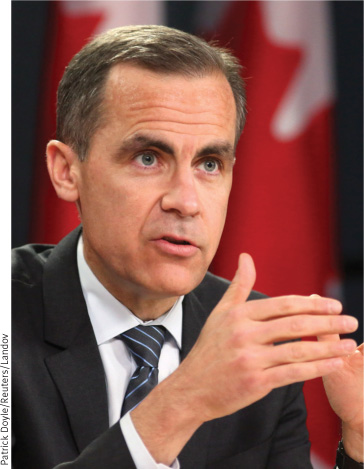Aggregate Demand and Aggregate Supply
12
How the aggregate demand curve illustrates the relationship between the aggregate price level and the quantity of aggregate output demanded in the economy
How the aggregate supply curve illustrates the relationship between the aggregate price level and the quantity of aggregate output supplied in the economy
Why the aggregate supply curve is different in the short run compared to the long run
How the AD–AS model is used to analyze economic fluctuations
How monetary policy and fiscal policy can stabilize the economy
SHOCKS TO THE SYSTEM

SOMETIMES IT’S NOT EASY BEING the boss. The Bank of Canada (BOC) is the institution that sets our monetary policy. Established in 1934, its primary goal is “to promote the economic and financial welfare of Canada.”
When the U.S. economy went into a recession in 2001, the BOC rushed cash into the Canadian system—
For much of 2008, however, Mark Carney (shown here), then governor of the BOC, faced a much more difficult problem: stagflation—a combination of unacceptably high inflation and rising unemployment. Stagflation caused troubles around the world in the 1970s: the two deep U.S. recessions of 1973-1975 and 1979-1982 were both accompanied by soaring inflation. While Canada only had a recession in 1981-1982, our economy experienced much slower real GDP growth and higher unemployment coupled with a high rate of inflation.
Why did the economic difficulties of late 2008 look so different from those of 2001? Because they had different causes. Therefore, they required different policy responses. The U.S. recession of 2001, like many recessions, was caused by a fall in investment and consumer spending. In episodes like this, high inflation isn’t a threat. So policy-
The U.S. recessions of the 1970s and slowdowns they brought to Canada, however, were caused largely by sharp cuts in world oil production and soaring prices for oil and other fuels. Not coincidentally, soaring oil prices also contributed to the economic difficulties of early 2008. In both periods, high energy prices led to a combination of high unemployment and high inflation. They also created a dilemma: should the BOC fight the slump by pumping cash into the economy, or should it fight inflation by pulling cash out of the economy, which could worsen the slump?
It’s worth noting, by the way, that in 2011 the BOC faced some of the same problems it faced in 2008, as rising oil and food prices led to rising inflation despite high unemployment. In 2011, however, the BOC was fairly sure that demand was the main problem. Therefore, it decided to stimulate aggregate demand by keeping interest rate at low levels.
In the previous chapter, we developed the income-
In this chapter, we’ll develop a model that will help us to distinguish between a demand shock, like that of the 2001 U.S. recession, and a supply shock, like that of the 2008 recession. To develop this model we’ll proceed in three steps. First, we’ll develop the concept of aggregate demand. Then we’ll turn to the parallel concept of aggregate supply. Finally, we’ll put them together in the AD-